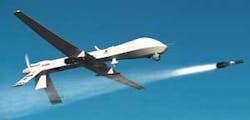By John McHale
The global unmanned aerial vehicle (UAV) market continues to grow at a substantial pace, mostly driven by the U.S. military, say market analysts in the U.S. and United Kingdom. Market analysts say the market will continue to increase each year and estimate the market will reach $17 billion by 2010.
“Wartime efforts and defense budget increases have fueled platform and equipment development, however current funding levels are putting pressures across the [U.S. Department of Defense (DOD)] budget,” says Darren Corbiere, Industry Analyst at Frost & Sullivan in Washington. “UA systems have proven vital components in supporting the global war on terror, particularly in Afghanistan and Iraq. They have also been able to provide real-time data and imagery to the warfighters while decreasing the risk to human life.”
Analysts at Visiongain in London see similar numbers to Frost with the world UAV market to reach $5.6 billion in 2007, exceed $10 billion by 2012, and record total revenues of approximately $15 billion in 2016.
The Predator UAV, which has armed and unarmed variants, has been a valuable tool for the U.S. military in Iraq and Afghanistan.
“Although commonly regarded as expendable, the acquisition costs of the more advanced UAVs may limit their uses, that they still have advantages over manned aircraft in the most dangerous environments,” Visiongain analysts argue in their report titled “The World UAV market 2006.”
In their report Visiongain analysts state they expect that the civil markets for UAVs will also expand, “but this will depend in part upon successful integration of UAVs into controlled airspace.”
According to their report, Visiongain analysts see the main UAV market opportunities in “advanced subsystems and payloads, as well as in associated support and training packages. The UAV is best seen as part of a “system of systems” where the main players will focus on developing networked systems and integrating their various elements.”
According to Visiongain the U.S. is the dominant UAV player with 163 declared UAV projects-the top five are the Navy and Marine Corps Pioneer, the Air Force Global Hawk and Predator, and the Army’s Hunter and Shadow. France has 50 UAV programs, Israel 31, Pakistan 25, Germany 23, and the United Kingdom 20.
The U.S. Quadrennial Defense Review (QDR) expects U.S. spending on UAVs to double over the next five years, Visiongain analysts state.
Frost analysts also see the U.S market facing other challenges, including that several unmanned aerial systems (UASs) commitments are questionable particularly with the U.S. Navy.
Other developments include the possibility that tactical and small UAVs may provide additional mission support across the services and in the commercial sector; UAS may provide lower-cost solutions; and the possibility that UASs may be unaffordable in the commercial sector.
Despite, these challenges, the U.S. UAS market has had considerable momentum due to recent operational successes and increasing mission roles, Corbiere says. “UAS market penetration in all four military services and the commercial sectors in surveillance and weaponized capabilities are also driving growth. Because of operational surveillance monitoring overseas, UA systems are also being considered for homeland security missions to support border and maritime security.”
According to Visiongain analysts, the European Union believes the market for civil UAVs in Europe will surge “dramatically from 2010 if the airspace and civil certification issue is resolved.” The EU civil market is forecast to grow to $300 million by 2015 and the EU military market is expected hit $1.2 billion by 2010.
For more information on the Frost study “U.S. Unmanned Aerial Systems Market” visit www.defense.frost.com. For more information on Visiongain see www.visiongain.com.

